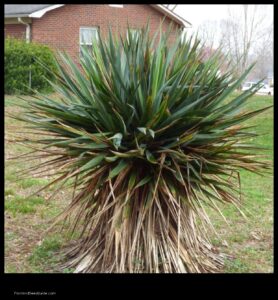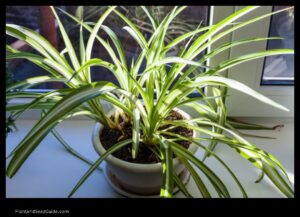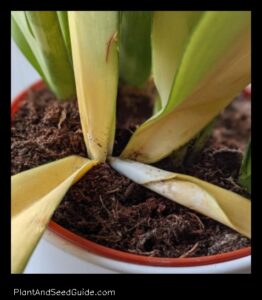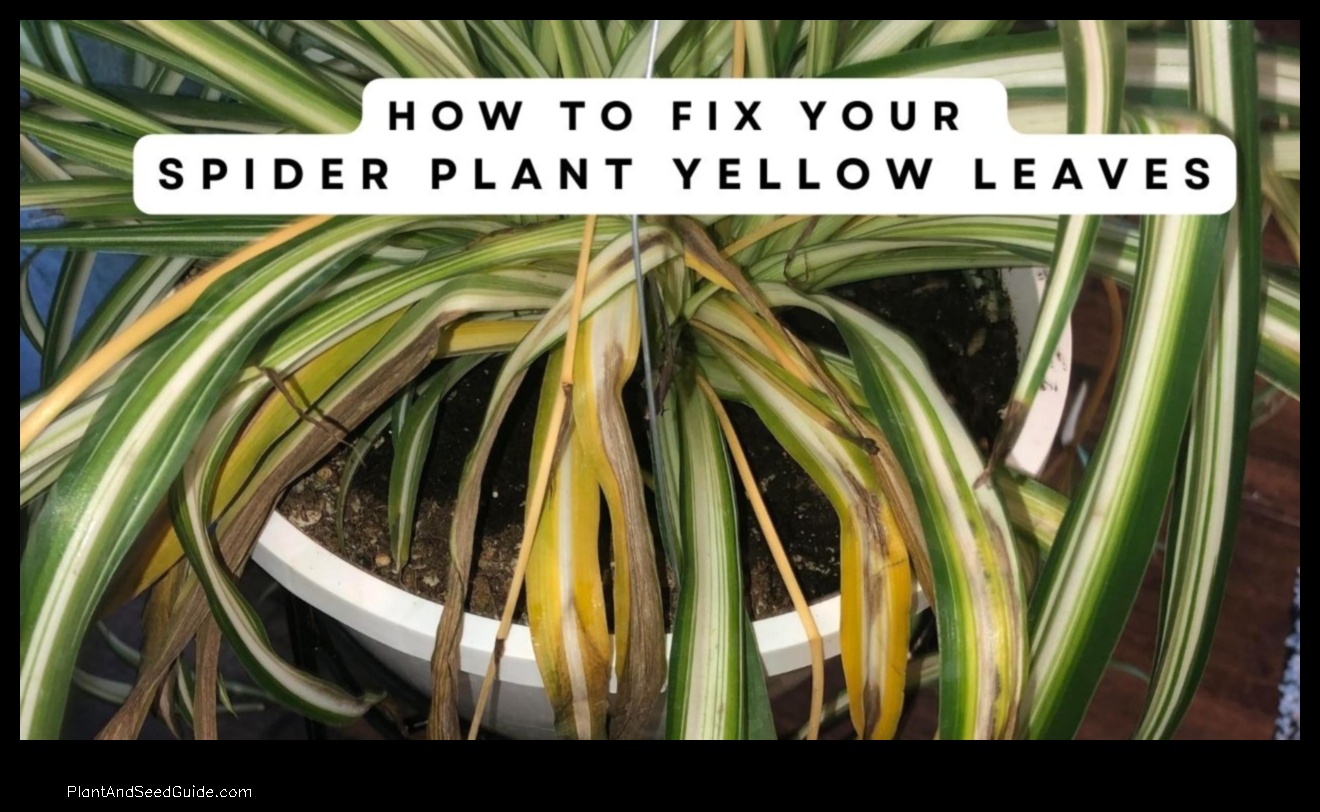
Why is my spider plant turning yellow?
Spider plants are susceptible to a number of problems that can cause the leaves to turn yellow. These problems include:
Overwatering: Spider plants are susceptible to root rot if they are overwatered. This can cause the leaves to turn yellow and eventually fall off.
Underwatering: Spider plants also need to be watered regularly, but not too much. If they are underwatered, the leaves will start to turn yellow and wilt.
Nutrient deficiency: Spider plants need a balanced fertilizer to thrive. If they are not getting enough nutrients, the leaves will start to turn yellow.
Sunburn: Spider plants can also get sunburned if they are exposed to too much direct sunlight. This can cause the leaves to turn yellow and dry out.
Insect infestation: Spider plants can be susceptible to a number of insect pests, such as aphids, mealybugs, and spider mites. These pests can suck the sap out of the leaves, causing them to turn yellow and eventually die.
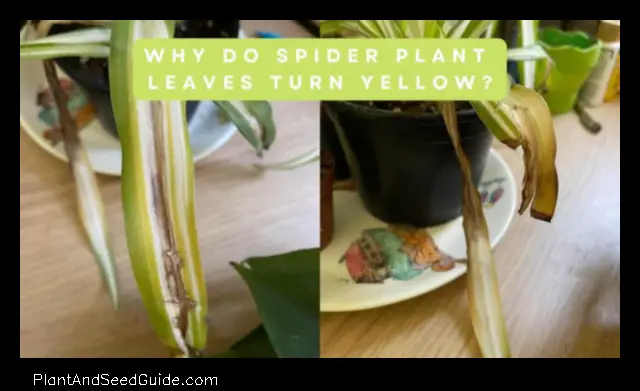
How to fix a yellowing spider plant
If you are seeing your spider plant turning yellow, it is important to first identify the cause of the problem. Once you have identified the cause, you can take steps to correct it and help your plant recover.
Overwatering: If you think your spider plant is being overwatered, you can try to reduce the amount of water you are giving it. You should also make sure that the pot has good drainage so that excess water can drain away.
Underwatering: If you think your spider plant is being underwatered, you can try to water it more frequently. You should also make sure that the pot has good drainage so that excess water can drain away.
Nutrient deficiency: If you think your spider plant is not getting enough nutrients, you can try to fertilize it with a balanced fertilizer. You should follow the directions on the fertilizer label carefully.
Sunburn: If you think your spider plant is getting too much direct sunlight, you can try to move it to a spot with more shade. You should also make sure that the pot has good drainage so that excess water can drain away.
Insect infestation: If you think your spider plant is infested with insects, you can try to treat it with an insecticidal soap or spray. You should follow the directions on the product label carefully.
Common causes of yellow leaves on spider plants
- Overwatering
- Underwatering
- Nutrient deficiency
- Sunburn
- Insect infestation
How to water a spider plant
Spider plants need to be watered regularly, but not too much. The best way to water a spider plant is to let the soil dry out slightly between waterings. You can check the soil by sticking your finger into it. If the soil is dry to the touch, it is time to water the plant.
You should also make sure that the pot has good drainage so that excess water can drain away. If the pot does not have good drainage, the roots of the plant can rot if they are constantly wet.
How much light does a spider plant need?
Spider plants do best in bright, indirect sunlight.
If you live in a sunny area, you may need to place your spider plant in a spot that gets filtered or dappled sunlight.They can tolerate some direct sunlight, but too much direct sunlight can cause the leaves to burn..
How to fertilize a spider plant
Spider plants do not need to be fertilized often. You can fertilize them once a month during the growing season (spring and summer). You can use a balanced fertilizer, such as a 10-10-10 fertilizer.
You should dilute the fertilizer to half strength before applying it to the plant. You can also apply the fertilizer to the soil around the plant, or you can mix it with water and water the plant with the solution.
How to propagate a spider plant
Spider plants are easy to propagate. You can propagate them by division or by stem cuttings.
To propagate by division, you will need to divide the plant into two or more sections. Each section should have at least one or
| Topic | Features |
|---|---|
| Spider plant turning yellow |
Overwatering Underwatering Nutrient deficiency Sunburn Insect infestation |
| Spider plant yellow leaves | The leaves will start to turn yellow and eventually fall off. |
| Spider plant care |
Water regularly, but not too much. Fertilize regularly with a balanced fertilizer. Expose to indirect sunlight. Protect from pests. |
| Spider plant problems |
Yellow leaves Wilting leaves Root rot Pest infestation |
| Yellow leaves on spider plant | A sign of overwatering, underwatering, nutrient deficiency, sunburn, or insect infestation. |
Why is my spider plant turning yellow?
There are a number of reasons why a spider plant might be turning yellow. Here are some of the most common causes:
- Overwatering: Spider plants are susceptible to root rot if they are overwatered. This can cause the leaves to turn yellow and eventually fall off.
- Underwatering: Spider plants also need to be watered regularly, but not too much. If they are underwatered, the leaves will start to turn yellow and wilt.
- Nutrient deficiency: Spider plants need a balanced fertilizer to thrive. If they are not getting enough nutrients, the leaves will start to turn yellow.
- Sunburn: Spider plants can also get sunburned if they are exposed to too much direct sunlight. This can cause the leaves to turn yellow and dry out.
- Insect infestation: Spider plants can be susceptible to a number of insect pests, such as aphids, mealybugs, and spider mites. These pests can suck the sap out of the leaves, causing them to turn yellow and eventually die.
If you are seeing your spider plant turning yellow, it is important to first identify the cause of the problem. Once you have identified the cause, you can take steps to correct it and help your plant recover.
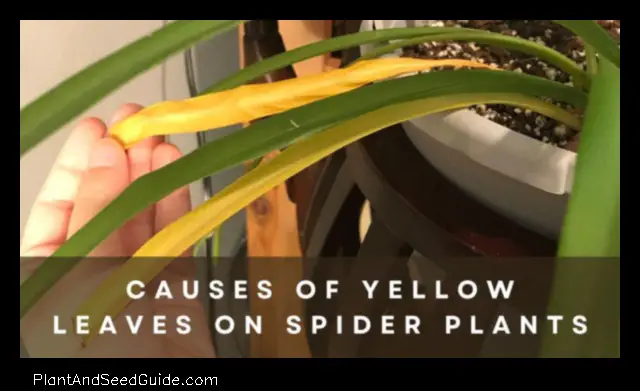
Common causes of yellow leaves on spider plants
The following are some of the most common causes of yellow leaves on spider plants:
-
Overwatering
-
Underwatering
-
Nutrient deficiency
-
Sunburn
-
Insect infestation
IHow to fix a yellowing spider plant
To fix a yellowing spider plant, you will need to first identify the cause of the problem. Once you have identified the cause, you can take steps to correct it and help your plant recover.
Overwatering: If your spider plant is overwatered, you will need to reduce the amount of water you are giving it. Allow the soil to dry out completely between waterings.
Underwatering: If your spider plant is underwatered, you will need to increase the amount of water you are giving it. Water the plant thoroughly until the water runs out the bottom of the pot.
Nutrient deficiency: If your spider plant is not getting enough nutrients, you will need to fertilize it. Use a balanced fertilizer that is specifically formulated for houseplants.
Sunburn: If your spider plant is getting too much direct sunlight, you will need to move it to a location with more indirect light.
Insect infestation: If your spider plant is infested with insects, you will need to treat it with an insecticidal soap or neem oil.
Once you have corrected the cause of the problem, your spider plant should start to recover. Continue to care for your plant properly and it should be back to its healthy green color in no time.
How to water a spider plant
Spider plants are relatively easy to care for, but they do need to be watered regularly. The best way to water a spider plant is to allow the top 2-3 inches of soil to dry out before watering again. You can also check the soil moisture by sticking your finger into the pot. If the soil feels dry to the touch, it is time to water the plant.
When you water a spider plant, be sure to water it thoroughly until the water comes out of the drainage holes in the bottom of the pot. Then, empty the water that has accumulated in the saucer under the pot.
It is important not to overwater a spider plant, as this can lead to root rot. However, it is also important not to underwater a spider plant, as this can also cause the leaves to turn yellow and wilt.
If you are not sure how often to water your spider plant, err on the side of caution and water it less frequently. You can always water the plant more often if it starts to look wilted.
VHow to fertilize a spider plant
Spider plants do not need a lot of fertilizer, but they will benefit from a light application of fertilizer once a month during the growing season. You can use a balanced fertilizer, such as a 10-10-10 fertilizer, or a fertilizer specifically formulated for houseplants.
To fertilize your spider plant, simply mix the fertilizer according to the package directions and water your plant with the solution. Be sure to water the plant thoroughly so that the fertilizer is evenly distributed throughout the soil.
Do not fertilize your spider plant during the winter months, as this can damage the plant.
Here are some tips for fertilizing your spider plant:
Use a balanced fertilizer, such as a 10-10-10 fertilizer.
Water your plant thoroughly so that the fertilizer is evenly distributed throughout the soil.
Do not fertilize your spider plant during the winter months.
How to propagate a spider plant
Spider plants are easy to propagate, and you can do it with just a few simple steps.
1. Choose a healthy leaf with at least two nodes. A node is the point where a leaf meets the stem.
2. Cut the leaf off the stem with a sharp knife or scissors. Make sure to leave at least 2 inches of stem on the leaf.
3. Place the leaf in a glass of water. Make sure the water level is high enough to cover the nodes, but not so high that it touches the leaves.
4. Place the glass in a bright spot, but out of direct sunlight.
5. Change the water every few days.
6. Once the roots are about 2 inches long, you can plant the leaf in a pot of soil. Water the plant regularly and fertilize it monthly.
Your spider plant should start to grow new leaves within a few weeks.
How to transplant a spider plant
Transplanting a spider plant is a relatively simple process, but it is important to do it correctly in order to avoid damaging the plant. Here are the steps involved in transplanting a spider plant:
1. Choose a pot that is the correct size for the plant. The pot should be about 2 inches wider and deeper than the root ball of the plant.
2. Fill the pot with a well-draining potting mix. You can use a commercial potting mix or make your own by mixing equal parts potting soil, perlite, and sand.
3. Gently remove the spider plant from its old pot. Be careful not to damage the roots.
4. Place the spider plant in the new pot and fill in around the roots with potting mix. Firmly press the potting mix around the roots to help support the plant.
5. Water the spider plant thoroughly.
6. Place the spider plant in a bright, indirect location.
Your spider plant should start to grow new roots and leaves within a few weeks. Once the plant has established itself in its new pot, you can begin to fertilize it and water it as you would normally.
Q: Why is my spider plant turning yellow?
A: There are a number of reasons why a spider plant might be turning yellow. Here are some of the most common causes:
Overwatering: Spider plants are susceptible to root rot if they are overwatered. This can cause the leaves to turn yellow and eventually fall off.
Underwatering: Spider plants also need to be watered regularly, but not too much. If they are underwatered, the leaves will start to turn yellow and wilt.
Nutrient deficiency: Spider plants need a balanced fertilizer to thrive. If they are not getting enough nutrients, the leaves will start to turn yellow.
Sunburn: Spider plants can also get sunburned if they are exposed to too much direct sunlight. This can cause the leaves to turn yellow and dry out.
Insect infestation: Spider plants can be susceptible to a number of insect pests, such as aphids, mealybugs, and spider mites. These pests can suck the sap out of the leaves, causing them to turn yellow and eventually die.
Q: How can I fix a yellowing spider plant?
A: If you are seeing your spider plant turning yellow, it is important to first identify the cause of the problem. Once you have identified the cause, you can take steps to correct it and help your plant recover.
Overwatering: If you think your spider plant is being overwatered, you can try to reduce the amount of water you are giving it. You can also try to improve the drainage in your pot by adding more perlite or gravel to the soil.
Underwatering: If you think your spider plant is being underwatered, you can try to water it more frequently. You can also try to increase the humidity around your plant by placing it in a pebble tray or by misting the leaves regularly.
Nutrient deficiency: If you think your spider plant is not getting enough nutrients, you can try to fertilize it with a balanced fertilizer. You can also try to add compost or worm castings to the soil to help improve the nutrient content.
Sunburn: If you think your spider plant is getting too much direct sunlight, you can try to move it to a shadier location. You can also try to cover the plant with a sheer curtain or shade cloth to protect it from the sun.
Insect infestation: If you think your spider plant is infested with insects, you can try to treat it with an insecticidal soap or neem oil. You can also try to hand-pick the insects off the plant.
FAQ
Q: Why is my spider plant turning yellow?
A: There are a number of reasons why a spider plant might be turning yellow. Some of the most common causes include:
Overwatering
Underwatering
Nutrient deficiency
Sunburn
Insect infestation
Q: How can I fix a yellowing spider plant?
A: If you think your spider plant is turning yellow due to overwatering, underwatering, or nutrient deficiency, you can try the following:
If you think your spider plant is overwatered, let the soil dry out completely before watering again.
If you think your spider plant is underwatered, water it more frequently.
If you think your spider plant is suffering from a nutrient deficiency, fertilize it with a balanced fertilizer.
If you think your spider plant is getting too much sun, move it to a shadier spot.
If you think your spider plant is infested with insects, treat it with an insecticide.
Q: How can I prevent my spider plant from turning yellow?
A: To prevent your spider plant from turning yellow, you can follow these tips:
Water your spider plant regularly, but not too much.
Fertilize your spider plant with a balanced fertilizer once a month.
Place your spider plant in a spot where it will get bright, indirect light.
Inspect your spider plant regularly for signs of pests and diseases, and treat them as soon as possible.
- Wild Rose Country: Exploring Untamed Beauty - July 15, 2024
- Wildflower Nursery Decor: Bringing Nature Indoors - July 15, 2024
- Young Sprout of Grass: Nurturing New Life - July 15, 2024





